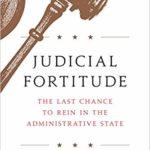Constitutional Conundrums, Resolved: Part 2

If and when the Supreme Court has a solid conservative majority, what should it do? Where do we go from here?
If we were starting from scratch—writing on a blank slate, so to speak—the disparate elements of the Right would go off in many different directions, as chronicled in Part 1. A new Court allows a pivot, not a do-over. How should the new majority use this opportunity? The Age of Trump is characterized by disruption, so we must set aside our preconceptions, without being foolhardy. Reasonable people can differ, and not all my colleagues will agree with my proposed course. Some will accuse me of being milquetoast—aiming too low. Others will regard my suggestions as imprudent, even reckless. Conservatives can be a quixotic (and sometimes even cantankerous) bunch. We need to have a plan, and it has to be both ambitious and realistic. Let the dialogue begin.

The first installment of this series asked “What is the nature of our present dilemma, and how did we get here?” I ended Part 1 by declaring that “constitutional conservatives in the Age of Trump must rise up from the ‘defensive crouch’ they have been in for decades and boldly confront the reality they face: With an ailing Justice Ruth Bader Ginsburg soon to depart the Court, and the 80-year old Stephen Breyer possibly next to follow, President Trump may be in a position to realign the Court in a conservative direction—for decades to come.”

So far, Trump has filled the seat held by the late Antonin Scalia with Justice Neil Gorsuch, and replaced the unreliable, swing-voting Anthony Kennedy (whom others have described as “an unprincipled weathervane”) with Justice Brett Kavanaugh. While some conservatives fear that Chief Justice John Roberts may assume the centrist role previously held by Justices Kennedy and Sandra Day O’Connor (the appointment of whom were two of President Reagan’s biggest mistakes), if Trump gets the chance to replace the frail Ruth Bader Ginsburg (Amy Coney Barrett is the leading contender), a solid conservative majority will be assured. The ideological shift may prompt the 80-year old Breyer to step down; serving on the Supreme Court becomes much less fun when the role is reduced to writing dissenting opinions. Trump’s list of potential SCOTUS nominees is generally quite robust.


Assuming that a decisive conservative majority on the Court comes to pass, the question “Where do we go from here?” would become an urgent call to action. As activist Justice William J. Brennan cynically informed his new law clerks each term, the most important rule in constitutional law is the “rule of five.” With five votes, Brennan would remind his clerks, the Court “could do anything.” During his 34 years on the Court (1956-1990), Brennan used the “rule of five” to lead the Court in an aggressively-liberal direction. He was both the coach and quarterback for much of the Warren Court’s progressive activism, authoring an astonishing 1,360 opinions (second only to the even-more-radical Justice William O. Douglas). Scalia rated Brennan “probably the most influential justice of the [20th] century.”

We are nearing the point that the “rule of five” math is finally turning in conservatives’ favor, for the first time since FDR was President, over 80 years ago. What should a conservative Supreme Court do? One approach, favored by many grassroots conservatives, would be the wholesale reversal of decades of progressive decisions—wiping the slate clean, immediately. If all the conservative and libertarian critiques of the Supreme Court written over the past half-century—and there have been many [1]–were aggregated, and then implemented, a good portion of the body of judge-made constitutional law since the 1930s would be obliterated. Poof! Gone!
This would be a jurisprudential equivalent to the country music song by Rascal Flatts, Backwards, which explains what happens when you play a country song backwards:
You get your house back
You get your dog back
You get your best friend Jack back
You get your truck back
You get your hair back
Ya get your first and second jobs back
Your front porch swing
Your pretty little thing
Your bling bling bling and a diamond ring
You get your farm and the barn and the boat and the Harley
That old black cat named Charlie
You get your mind back
You get your nerves back
Your achy breaky heart back
You get your pride back
You get your life back
You get your first real love back
You get your big screen TV, a DVD and a washing machine
You get the pond and the lawn
And the rake and the mower
You go back where life was slower
Rascal Flatts gently mocked the genre of country music by itemizing the laments and tribulations often featured in country songs:
It sounds a little crazy, a little scattered and absurd
But that’s what you get
When you play a country song backwards
Alas, constitutional law is not the same as the stereotypical tropes and cliched themes in country music songs, although many of the policy outcomes in SCOTUS decisions reflect equally-cliched intellectual fads and fashions on the Left. “If we could just rewind it all and go back in T-I-M-E,” as Rascal Flatts jokingly suggested, is not an option in real life. A Trump Court cannot, as a practical matter, simply overrule an entire body of past decisions in a wholesale fashion–with a wave of a gavel–to get our historical Constitution back. Stare decisis, a self-imposed constraint appellate judge place on themselves to prevent willy-nilly reversals of common law (or judge-made) doctrine, promotes predictability in the law and nurtures public trust in the judicial branch, at the expense of abrupt policy reversals that one might expect from the political branches after power changes hands following an election. The Constitution is not an Etch-a-Sketch. Nor should it be. The Supreme Court’s caselaw does not have a “reset” button.

Purists will argue that constitutional law precedents—merely judicial decisions—do not have the same weight as the text of the Constitution itself. And they are right, but the Supreme Court’s moral authority derives from the public’s willingness to accept its decisions as reasonable, good faith interpretations of the Constitution. Whether, and to what extent, particular precedents should be overruled is a nuanced and sometimes difficult inquiry. Many countervailing considerations must be balanced. On the one hand, the Court has betrayed the public’s trust by steadily and incrementally adopting a body of constitutional law that is not plausibly based on the Constitution, and which in many cases is contrary to the original understanding of the Constitution. Phony constitutional law decisions are a lie. Judicial usurpations are fundamentally illegitimate, and constitute an affront to democracy.
On the other hand, suddenly reversing all of the Court’s bad decisions (or even certain critical components) within a short period of time could destroy the Court’s carefully-cultivated image as a neutral umpire. (Notwithstanding the body of criticism cited in footnote 1, the Court—by virtue of its marble columns, black robes, and solemn ceremonies—is still regarded more favorably than Congress.) While it true that progressive activists have managed to implement much of their vision of a “living Constitution” in place of the version drafted by the Founders and ratified by the states, they have done so in the manner of boiling a frog—slowly. What has taken decades to achieve cannot be reversed in one fell swoop. Stare decisis is the damper that prevents sudden or radical doctrinal shifts by the Court.

There is a middle ground between maintaining the status quo and radical change: a gradual change in direction, accompanied by a convincing explanation of the Court’s past error. The conservative majority on the Court may last for decades, so some patience is warranted—and justified.
Stare decisis is not necessarily a bad thing. For one thing, it does not prevent doctrinal reversals; it only requires that they be done cautiously, for prescribed reasons, and with an explanation. The standard justices use to determine whether a past decision should be overruled is admittedly malleable, and therefore manipulable, but it still imposes some degree of discipline. No one believes the Court is infallible, but it is important for the public to trust the Court to act in good faith—to try to reach the correct result when interpreting the Constitution. Occasional mistakes will be forgiven, but blatantly-political decisions will not. Recall the once-ubiquitous “Impeach Earl Warren” billboards in the 1960s, which corroded public confidence in the judiciary (but concededly did not seem significantly to restrain the Court’s activism).

The Court has made mistakes in the past (Dred Scott is an obvious example), and has clumsily flip-flopped on busing and the death penalty. The Court has subsequently acknowledged (and usually corrected) those mistakes without forfeiting its institutional credibility. When necessary to correct egregious past mistakes, periodic “course corrections” do not detract from the Court’s judicial “mystique.” Rectifying judicial errors in a measured fashion could actually enhance the Court’s authority in the long run. Overruling Roe v. Wade, for example, would demonstrate that the Court is serious about interpreting the Constitution as written, and that it will not countenance judicial usurpation of a policy question properly left to the political branches—ideally at the state level. Roe symbolizes—indeed, exemplifies–judicial overreach. Roe must be overruled as soon as possible if the Court is to be taken seriously as a neutral arbiter—an honest umpire calling balls and strikes.
The first factor the Court considers in overruling a prior decision is whether the precedent in question was plainly wrong and/or badly-reasoned. Roe is both—arguably the most lawless decision ever issued by the Supreme Court. Other factors in the stare decisis analysis consider the extent of social, economic, and government “reliance” on the precedent in question. Roe has never been accepted as a legitimate interpretation of the Constitution and continues to engender intense public criticism decades after it was issued. To Roe’s pro-life critics, the decision unleashed a ghastly death toll—over 60 million abortions in the U.S. since 1973. Even liberal academics have scoffed at Roe’s flimsy “reasoning.” Overruling Roe would simply leave the regulation of abortion to the states, where it belongs. Roe is the easiest case to overrule under a stare decisis analysis. Others are somewhat more complicated.

Some bells simply can’t be un-rung. Some grassroots conservatives may not want to accept this, but we cannot, realistically, turn the clock back to before the Warren Court era, let alone to prior to the New Deal revolution [2], or even earlier. We can’t get the gold standard back. The basic contours of the modern welfare state (including Social Security) have hardened into impregnable entitlements, impervious to judicial challenges. The “incorporation doctrine” is here to stay; whether historically sound or not, the Bill of Rights applies to the states. Thus, the “federalization” of criminal procedure (Miranda, Brady, the exclusionary rule, etc.) is permanent, although the Court should stop digging the hole deeper by expanding questionable Warren Court precedents.
The Lochner doctrine (i.e., substantive due process protection for unenumerated economic liberties) was not originalist and in any event is gone forever. We probably can’t get school prayer back, either. [3] Despite the states’ failure timely to ratify the Equal Rights Amendment, the Court would face massive resistance if it returned to rational basis (or even “intermediate scrutiny”) review for classifications involving sex, which once allowed sexually-segregated schools such as Virginia Military Institute. Even though the 14th Amendment was not intended to deal with sex discrimination, male-only admissions were banned in United States v. Virginia, 518 U.S. 515 (1996), a decision authored by Justice Ginsburg, which provoked one of Justice Scalia’s most passionate—and eloquent—dissents. So we probably can’t get an all-male VMI back, either.

The tide has turned in some areas, but not across-the-board. Many errors are correctable, and should be corrected in due course. Obergefell should be overruled, along with Roe, at the first opportunity. Obergefell was narrowly-decided, fairly recently, amidst considerable controversy. Its reasoning was highly dubious, and it concerns a subject—the definition of marriage–long thought to be a matter most appropriate for regulation by the states. Going forward, “cultural” issues and questions of morality not expressly governed by the Constitution should be left to the states. This is how federalism is supposed to work. If there is sufficient public support for same-sex marriage, and other legal rights for homosexuals, they can be enacted through the political process, state-by-state. Many other 5-to-4 decisions in recent years should be revisited. Grutter and Fisher should be overruled in favor of a color-blind Constitution.
Some aspects of the New Deal jurisprudence are off-limits, but the Court should temper the worst aspects of the modern administrative state by overruling bad decisions such as Chevron v. NDRC and Auer v. Robbins, limiting the scope of Congress’s commerce clause power (overruling Wickard v. Filburn), and reviving the non-delegation doctrine. [4] Priorities must be established, and a top priority should be restoring the separation of powers contemplated by the Framers by limiting the power and influence of unaccountable administrative agencies. Many factions on the Right agree on this point, including Claremont’s John Marini (author of Unmasking the Administrative State, edited by Ken Masugi), AEI’s Peter Wallison (author of Judicial Fortitude), Columbia’s Philip Hamburger (author of Is Administrative Law Unlawful?), and many libertarians. This is a remarkable degree of consensus among often-contentious camps.

Wallison’s Judicial Fortitude (2018) begins with these words: “It is not too much to say that we risk losing our democracy unless we can gain control of the agencies of the administrative state.” Lawmaking and adjudication by deep state bureaucrats are an insult to the architecture of the Constitution, which delegated those functions to the Congress and the judicial branch, respectively. The well-defined and complementary roles of the three branches are essential to maintaining equilibrium in our constitutional system. The “checks and balances” in the Constitution are critically important. Unless we correct the imbalance of power represented by the alphabet soup of administrative agencies, the federal government will remain in the hands of unelected apparatchiks—The Swamp, in modern parlance.
The administrative state—government by bureaucracy—represents a grave threat to representative self-government. Before he passed, even Justice Scalia—an administrative law enthusiast—began to recognize that bowing to unelected bureaucrats in the form of “Chevron deference” was a colossal mistake. Allowing Congress to delegate lawmaking to executive branch agencies was an even greater mistake—and one with momentous consequences. Congress’s improper delegation of lawmaking authority to administrative agencies (via “rulemaking”) foils democracy by allowing our elected representatives in the House and Senate to point the finger of blame elsewhere for politically-unpopular policy outcomes. The Framers realized that lawmaking power must be accompanied by democratic accountability.

The power of the administrative state is a more important issue than one might initially think. With a majority of the Court, conservatives can roll back much of the activism that has characterized the judiciary since the New Deal—including the impudent, ongoing “resistance” of rogue lower courts. The Court will refrain from creating “new” rights through the alchemy of “emanations” and “penumbras.” But unless some way is found to limit the scope of activities of administrative agencies, that arena—now firmly under the cultural and political control of the Left—will produce all the progressive “jurisprudence” that the Left might want. Witness, for example, the disparate-impact theory developed by the EEOC under Title VII (there’s an “emanation” for you), or the sexual harassment rules of the Department of Education–a threat to free speech theoretically based on an unrelated statute (Title IX). The EPA, DOE, Department of Labor, and many other agencies are fiefdoms filled with leftist activists and social justice warriors, who are oblivious to the 2016 election. They must all be disempowered.

Progressives in academia and the media will howl in protest if the Court changes course. Conservatives must ignore the faux hysteria, and the center-right professoriate must unite in support of the conservative Court’s new direction. [5] The dithering, bickering, and silly internecine quarrels that I described in Part 1 must end. [6] No more Tower of Babel from the Right. Libertarians’ preoccupation with arcane theories based on long-moribund clauses of the Constitution (such as their inexplicable fascination with the Ninth Amendment and the “privileges or immunities” clause of the 14th Amendment) is a distraction and a waste of time. Likewise, conservatives should focus on arguments that have a realistic chance of success, unlike natural law theories and promoting an Article V convention of states. [7] Conservatives and libertarians should start exhibiting the same team play that liberals display. We must work together to restore the republic intended by the Founders. Let us put aside the labels: originalism (“new” and “old”), judicial engagement, judicial restraint, etc. We must agree on the fundamental principles of constitutionalism: the separation of powers, checks and balances, federalism, limited government, religious liberty, property rights, and respect for state sovereignty.

Change is afoot, and the center-right professoriate should embrace it. For the first time in many decades, the Supreme Court is poised to unravel the unprincipled mess of activist rulings masquerading as constitutional law—a legacy of accumulated dereliction and overreach which has led the nation to the brink of the abyss. This is a once-in-a-lifetime opportunity. The Court will face withering criticism from the Left for any deviation from the status quo. A conservative Court badly needs, and deserves, the full support of all those on the Right, including the historically-fractious professoriate. Working together, we can make the Supreme Court great again, in the process restoring the splendor of the Constitution and preserving freedom and the rule of law. To paraphrase Harvard’s Mark Tushnet, the era of “defensive crouch” constitutionalism is over: “They lost, we won.” Let’s act accordingly.

[1] Perhaps no element of the progressive agenda has been so consistently—and vehemently–opposed by conservatives as judicial activism. In addition to the “canon,” listed in Part 1, a partial list of books featuring conservative critiques of the Supreme Court would include Rosalie Gordon’s Nine Men Against America (1958), Alexander Bickel’s The Least Dangerous Branch (1962), L. Brent Bozell’s The Warren Revolution (1966), Lino Graglia’s Disaster by Decree (1976), Frank Carrington’s Neither Cruel nor Unusual (1978), William Eaton’s Who Killed the Constitution? (1988) (with a foreword by Senator Chuck Grassley), Earl Maltz’s Rethinking Constitutional Law (1994), William Gangi’s Saving the Constitution from the Courts (1995), David Barton’s Original Intent (1996), Matthew Franck’s Against the Imperial Judiciary (1996), Pat Robertson’s Courting Disaster (2004), Phyllis Schlafly’s The Supremacists (2004), Mark Levin’s Men in Black (2005), Kevin Gutzman’s The Politically Incorrect Guide to the Constitution (2007), Thomas Woods’ and Kevin Gutzman’s Who Killed the Constitution? (2008), Adam Freedman’s The Naked Constitution (2012), Mark Levin’s The Liberty Amendments (2013), Michael Stokes Paulsen’s and Luke Paulsen’s The Constitution: An Introduction (2015), Senator Mike Lee’s Our Lost Constitution (2015), and Peter Wallison’s Judicial Fortitude (2018). See also Richard Epstein’s How Progressives Rewrote the Constitution (2006). This list just scratches the surface and does not even attempt to itemize significant articles in scholarly and popular publications.
The constitutional law professoriate may sniff at the foregoing list and point out that most of the authors are not “serious academics” and that their points of view are “outside of the mainstream” (as defined by the professoriate). That is precisely my point. “Popular” books and articles on the Constitution have a far great audience than the “scholarship” of the Ivory Tower echo chamber (which talks mainly to itself), and more closely reflects the dominant public opinion about the Supreme Court—and the views of the current administration. The professoriate is out of the mainstream and ought to be accorded much less attention.
[2] One early author proposed a constitutional amendment stating that “all decisions of the Supreme Court, from 1937 to the date of the adoption of the proposal, should be declared to have no force and effect as precedents in judicial and other proceedings in determining the meaning of the words, sections, and provisions of the Constitution.” Gordon, supra note 1, at 120. This was an extreme proposal even when made in 1958, and is utterly impracticable today, but it shows the extent of popular discontent with the Court’s decisions. Texas Governor Greg Abbott has proposed a sweeping platform of constitutional amendments to be adopted at an Article V “convention of the states,” which he dubbed the Texas Plan. The level of discontent remains high, for good reason.
[3] The Warren Court, with the support of the legal culture, succeeded in distorting some constitutional norms, which the Court would understandably be reluctant to revisit. These errors need to be rectified by discrete constitutional amendments.
[4] Ditto the contract clause.
[5] “Originalists Against Trump” was an example of the circular firing squad that some libertarians and conservatives have become. Signatories included many prominent law professors and pundits, such as Steven Calabresi, Richard Epstein, Michael Stokes Paulsen, Jeremy Rabkin, Keith Whittington, Adam White, Kevin Walsh, and George Will. Would electing Hillary Clinton have been preferable to Donald Trump in any conceivable way (especially after he promised to select his SCOTUS appointments from an all-star list)? Yet, many luminaries (as well as some lesser lights) eagerly signed on to this fatuous NeverTrump screed. This was an expression of virtue-signaling by academics (and elite lawyers) whose professional world is overwhelming leftist in its orientation; they expected Hillary to win and wanted to display obeisance to the winning side—perhaps keeping a door open for future cocktail party invitations.
[6] Libertarians have far more in common with conservatives than they do progressives. Progressives despise the free market system, and all those who defend it, including libertarians. Duke historian Nancy MacLean’s unwarranted vilification of Nobel Prize-winning political economist James Buchanan in her controversial—and heavily-criticized–book, Democracy in Chains (2017), reveals the extent of the Left’s antipathy for all those who disagree with the progressive (i.e., socialist) agenda. David Bernstein has relentlessly exposed MacLean mendacious hackery (e.g., here, here, and here).
[7] Likewise, it is pointless—as well as erroneous–to question the doctrine of judicial review itself.
Thank you, How Appealing! And Instapundit (here)!
































